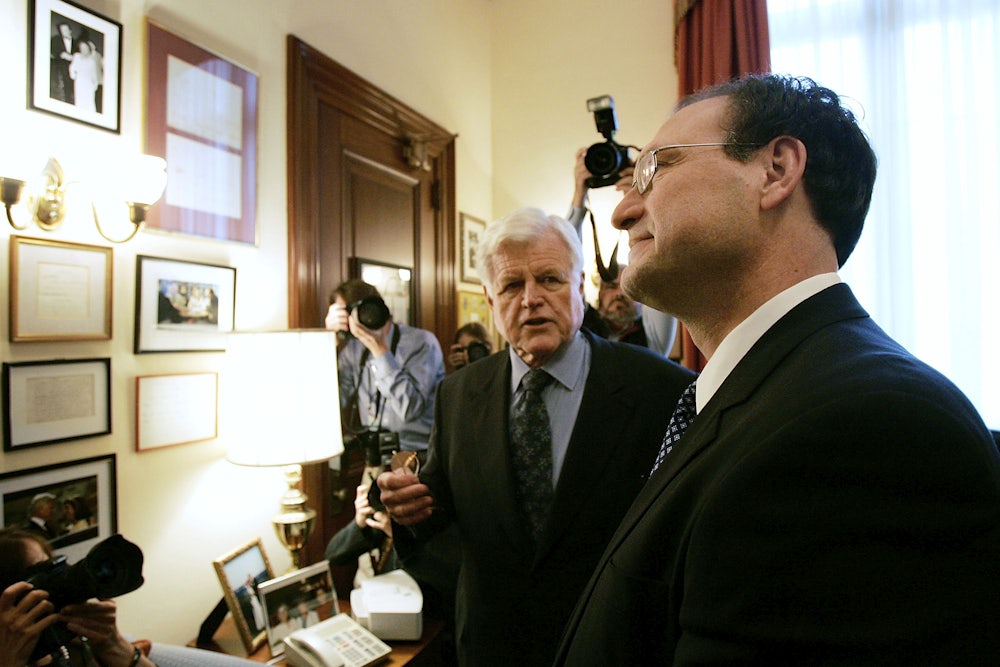Supreme Court Justice
Samuel Alito is in distress—or at least, he should be.
His troubles began two weeks ago, when The New York Times reported that an upside-down American flag was spotted flying at his Virginia home not long after the January 6 insurrection at the U.S. Capitol. (Though the upside-down flag originally was flown by sailors centuries ago to indicate distress, it has long been a political symbol in the United States, used most recently by Donald Trump supporters who claim the 2020 election was stolen.) And Alito’s troubles grew last week when the Times reported that another “provocative” flag—one carried by January 6 rioters—flew at his vacation home in New Jersey last summer.
Commentators expressed alarm that a Supreme Court justice would willfully, or through incredible ignorance, associate with an authoritarian movement that has trampled on the Constitution that he took an oath to uphold. Many prominent Democrats, including Representative Hakeem Jeffries, called on Alito to recuse himself from all forthcoming cases involving Trump and the attempted coup in 2021.
But Alito won’t recuse himself—and his brazen display of disloyalty to American democracy should surprise no one who recalls how he landed on the Supreme Court.
Alito’s hard-right ideology, and his shameless lack of ethics, were obvious when he was nominated by President George W. Bush in 2005. A few Democratic senators sounded the siren, but the mainstream media, even its so-called “liberal” mainstays, largely ignored the warnings, unwittingly cooperating with an elite, right-wing operation to install a dishonest, partisan extremist on the highest court of the country.
As The New York Times reported on the eve of Alito’s confirmation in 2006, his placement on the court was the “culmination” of an effort that began during the Reagan administration to staff the judiciary with ideologues of the religious right. Conservatives also deployed an adroit media strategy to temper, silence, and even disparage any attempt to criticize Alito during the nomination hearings. Public relations specialists and legal experts, coordinating on behalf of the Federalist Society, Christian organizations like Focus on the Family, and Republican senators, helped to sell Alito to the Senate, the media, and the public—even before his nomination. “We boxed them in,” one lawyer who participated in the meetings told the newspaper, presumably referring to the Senate and the mainstream media.
Early in the Alito nomination fight, Democrats uncovered a memo the judge wrote while he was working for the Reagan administration in 1985 that articulated his opposition to legal abortion. He advised against waging a “frontal assault on Roe” only because such a maneuver would prove politically unpopular, and instead advocated for a steady demolition of access to reproductive health care at the state level. Until the 2022 Dobbs decision overturning Roe, the Alito playbook is exactly what many Southern and heartland states followed to make abortion all but impossible within their borders.
The memo did not stop Alito from lying to the late Senator Edward Kennedy, whose diary revealed that, while meeting privately in Kennedy’s office, Alito assured him that he would never vote to overturn Roe. Unlike Republican Senator Susan Collins, who believed the same lie from Brett Kavanaugh and Amy Coney Barrett, Kennedy was not gullible enough to vote in favor of Alito’s confirmation.
The P.R. firm handling the Alito nomination insisted that Republicans counter with the claim that, as a lawyer for the Reagan administration, Alito was only reflecting the views of his client. Planned Parenthood warned that Alito would “gut Roe” if he had the opportunity, but the media soon dropped stories on the memo.
Similarly nauseating events transpired when Democrats learned that Alito belonged to Concerned Alumni of Princeton, an organization that opposed measures to increase admission of women and racial minorities. The group wasn’t merely against affirmative action but also contemptuous of co-education and supportive of quotas that favored men.
Alito insisted that his participation in the group was ancient history. (He had listed his membership on a job application as a 35-year-old applying to work for the federal government.) The mainstream media reacted not with questions about Alito’s biases on race and gender but with vilification of Democrats. Gloria Borger, a CNN commentator, accused the Democrats of “going over the line,” Newsweek likened Democratic senators to “bullies,” and PBS’s Gwen Ifill accused Alito’s critics of “demonization.” Chris Matthews and Chuck Todd had a conversation on MSNBC suggesting that it was absurd to try to “nail him” for belonging to a “club.”
Several reporters, including Katie Couric, focused on how Alito’s wife—whom the justice this month blamed for flying the upside-down flag—was crying when Democrats questioned him about his involvement in Concerned Alumni of Princeton.
Democrats would later learn that, as an appellate judge, Alito failed to recuse himself in two cases involving companies with which he had financial interest, even after he pledged to do so. The New York Times shielded Alito from suspicions over his lack of ethics, writing, “Legal ethics experts say judges are not obliged to recuse themselves in such cases.… Judge Alito has said the lapses were inadvertent and occurred long after the initial period covered by his pledge.” The Times framed the criticism of Alito not as an ethical worry but as a tactic from a “liberal coalition,” involving women’s rights groups, the NAACP, labor unions, and environmental organizations.
Kennedy gave a thunderous address on behalf of the people that the “liberal coalition” aimed to represent, warning on the Senate floor of the dangers of Alito’s extreme ideology: “If you are concerned and you want a justice that’s going to stand for the working men and women in this country—it’s not going to be Judge Alito. If you are concerned about women’s privacy rights, about the opportunity for women to gain fair employment in America—it’s not Judge Alito. If you care about the disabled … the Disability Act that we have passed to bring all of the disabled into our society, if you are looking for someone that is going to be a friend of the disabled—it’s not going to be Judge Alito. And finally, if you are looking for someone that is going to be willing to stand up to the executive branch of government … it’s not going to be Judge Alito.”
Kennedy attempted to organize a filibuster to prevent the confirmation of Alito, convincing Senators John Kerry, Hillary Clinton, and Barack Obama to join, but said that many Democrats were unwilling because of fears that Republicans would accuse them of obstructionism. In a 58–42 vote, with four Democrats joining the Republicans, Alito was confirmed on January 31, 2006.
Earlier this month, Nicolle Wallace, the MSNBC host, said the photos of Alito’s upside-down flags “stopped her in her tracks.” She likened them to a “body blow,” and wondered how we “got here.” Wallace was working for Bush when he nominated Alito to the court. Unlike most Americans living in what Gore Vidal called “the United States of Amnesia,” she should remember the deceitful strategy to install Alito on the court. Decades of right-wing subterfuge, media obsequiousness, and Democratic cowardice explain exactly how we “got here.”






